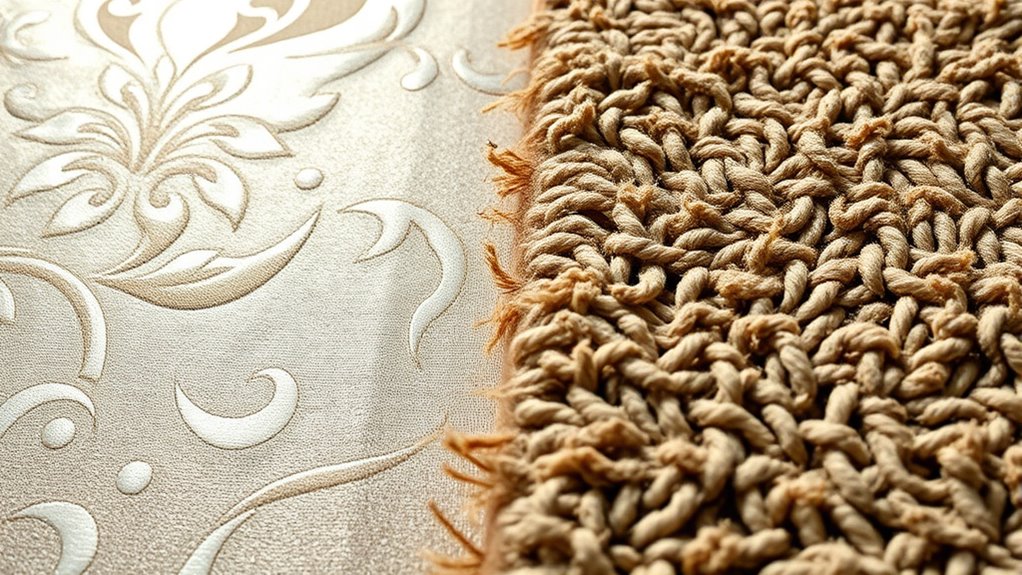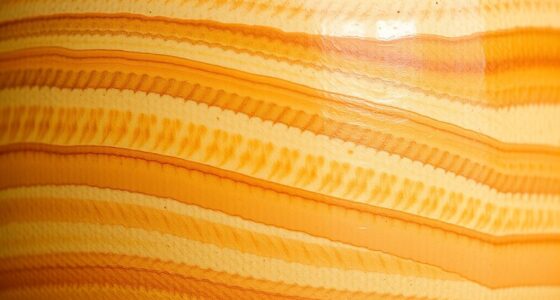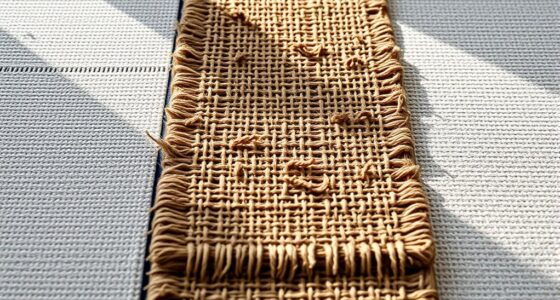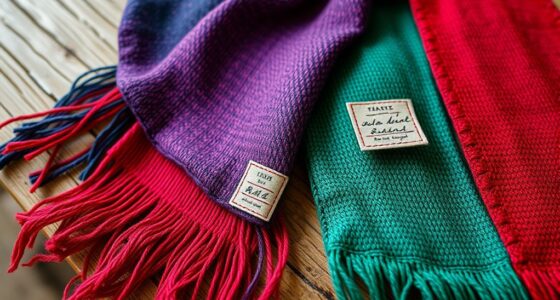Silk rugs offer a luxurious sheen and intricate detail but are delicate and require careful maintenance, making them less durable for high-traffic areas. Wool rugs are more resilient, resistant to wear, and easier to clean, ideal for busy spaces. Silk’s shine adds elegance, while wool’s matte finish gives a cozy vibe. To find out which suits your needs best, discover more about their longevity, care needs, and best spaces.
Key Takeaways
- Wool rugs are highly durable, resistant to wear and tear, making them suitable for high-traffic areas, while silk rugs are more delicate and prone to damage.
- Silk rugs have a luminous, reflective sheen that enhances luxury, whereas wool rugs typically offer a softer, matte finish with understated elegance.
- Wool rugs are easier to maintain, tolerate regular vacuuming, and resist stains, while silk rugs require gentle cleaning and prompt stain treatment.
- Silk’s fine weave allows for intricate patterns and a high sheen, but they wear faster; wool’s looser weave offers longevity and resilience.
- Wool rugs are generally more cost-effective and long-lasting, while silk rugs are a luxury investment with a shorter lifespan if not carefully maintained.
Material Composition and Weave Techniques
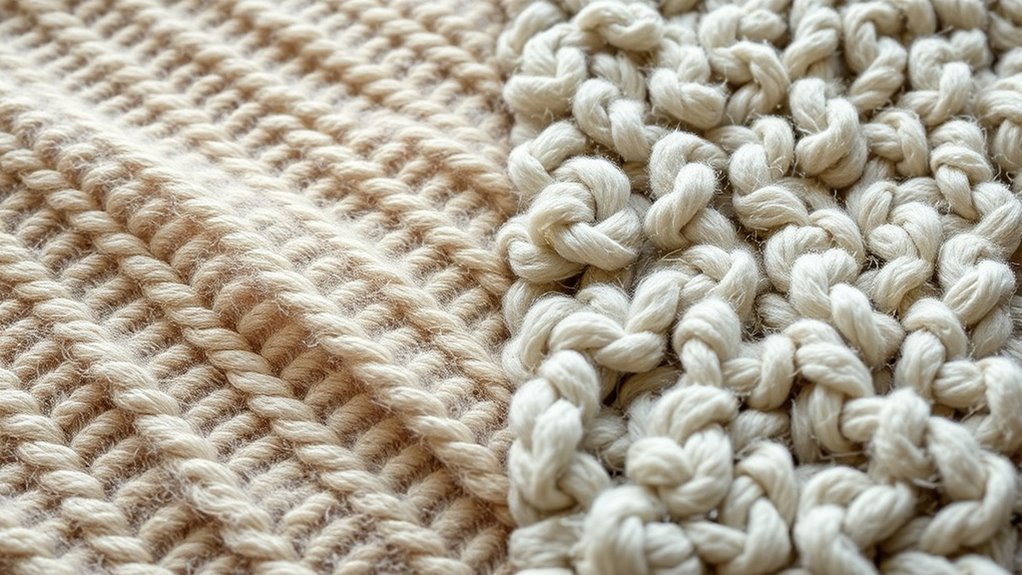
Silk and wool rugs differ markedly in their material composition and weave techniques, which directly impact their appearance and durability. Silk rugs are made from natural silk fibers, often woven with intricate, detailed patterns that highlight their sheen and fine craftsmanship. Wool rugs, on the other hand, use natural sheep’s wool, which tends to be more robust and textured. Some wool rugs incorporate synthetic fibers to enhance durability or affordability, but they still maintain traditional weaving methods. Wool rugs often feature bold, geometric patterns, emphasizing their durability and practicality. The weave techniques also vary: silk rugs are typically knotted tightly for a smooth, lustrous surface, while wool rugs may use looser weaves to create texture and resilience. These differences shape each rug’s overall look and lifespan. Additionally, understanding the material quality and weaving methods can help ensure you select a rug suited to your specific needs and aesthetic preferences. The choice between silk and wool also depends on factors like maintenance requirements, which can influence long-term satisfaction with the rug. Knowing the durability of each material can assist in choosing a rug that will withstand daily wear and tear.
Resistance to Wear and Tear
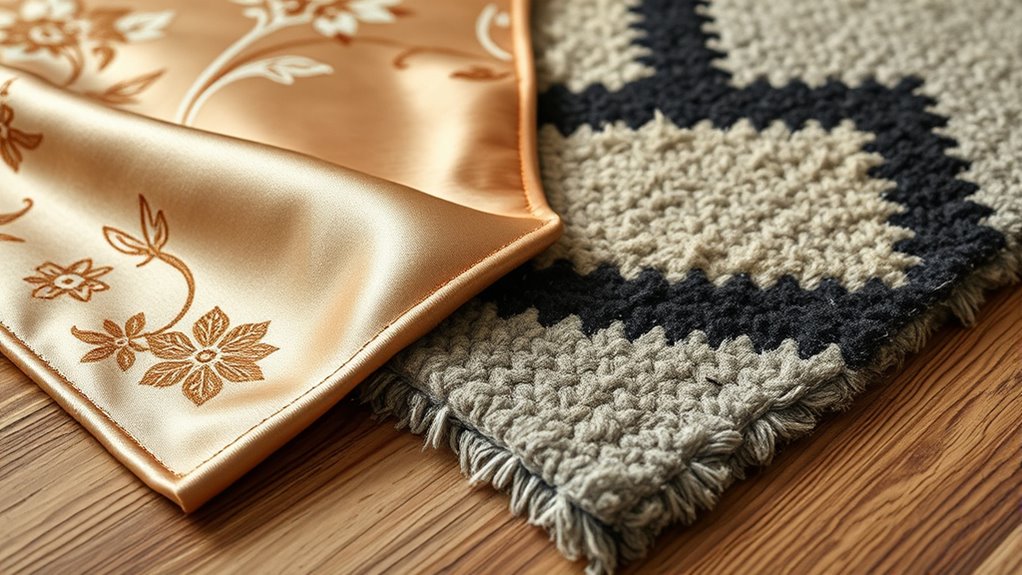
While the material composition and weave techniques influence a rug’s appearance, they also considerably affect how well the rug withstands wear and tear. Wool rugs are naturally durable, making them a solid choice for high-traffic areas, but they can trap pet dander, raising pet allergy concerns. Silk rugs, on the other hand, are more delicate and prone to damage from heavy foot traffic or rough handling. If you’re seeking allergy-friendly options, consider wool rugs with low pile and tight weaves, as they resist pet allergens better and hold up longer. Silk rugs may not be ideal for homes with pets or frequent activity, as they tend to wear faster. Overall, wool offers better resistance to wear and tear, especially with proper maintenance.
Longevity and Lifespan Expectations
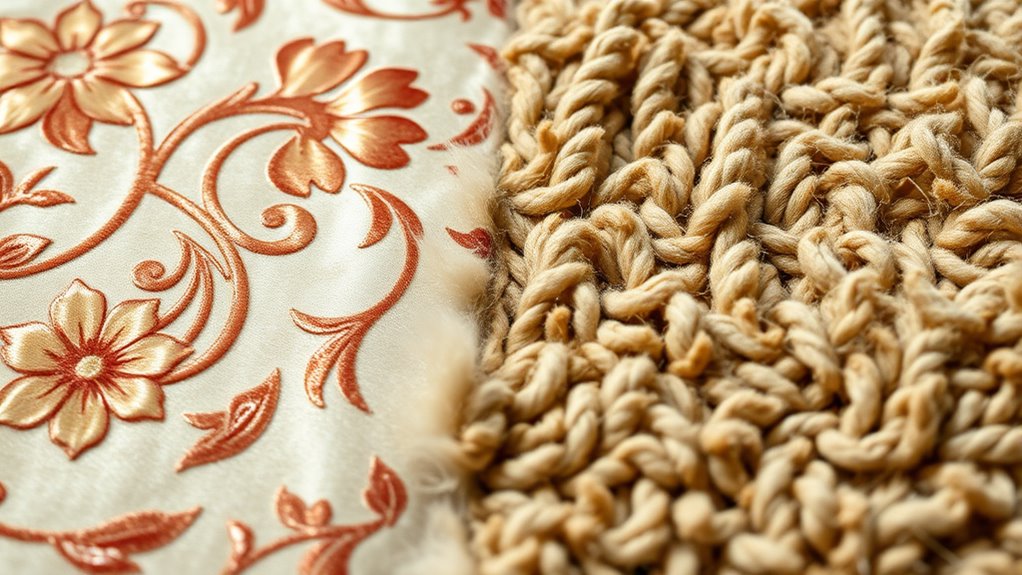
When it comes to longevity and lifespan, wool rugs generally outperform silk rugs due to their natural resilience. Wool’s high abrasion resistance helps it withstand daily foot traffic without showing significant wear, extending its useful life. Additionally, wool fibers have better fade longevity, meaning they resist color fading from sunlight over time. Wool’s abrasion resistance contributes significantly to its durability, making it suitable for high-traffic areas. Wool rugs also tend to be easier to clean and maintain, which helps preserve their appearance over the years. Their cost-effectiveness further enhances their appeal for long-term use. Wool’s natural resilience is a key factor in its ability to endure regular use while maintaining appearance. Silk rugs, while luxurious, tend to be more delicate and susceptible to damage from abrasion, which can shorten their lifespan. They also fade more quickly when exposed to sunlight, requiring more careful placement and maintenance. If durability and a longer lifespan are your priorities, wool rugs offer a more resilient choice. Furthermore, wool’s durability makes it a preferred option for areas subject to frequent use. Silk rugs, however, excel in appearance but may need more care to maintain their beauty over the years.
Visual Appeal and Sheen Characteristics

Your rug’s natural sheen can vary markedly, affecting its overall look. Silk rugs often have a luminous, reflective surface, while wool rugs tend to have a softer, more matte appearance. These differences in sheen and texture influence the visual texture and how the rug complements your space. Understanding how trailer music techniques can enhance emotional impact helps in appreciating how different materials create distinct visual impressions. Additionally, the sheen characteristics can impact the perceived quality and elegance of the rug, influencing your decorating choices. Recognizing how material properties contribute to these visual effects can further assist in selecting the perfect rug for your interior design, much like how sound design techniques shape the atmosphere of a scene to evoke specific emotions. Proper maintenance, such as regular cleaning and care, ensures that the sheen and appearance of your rug are preserved over time, maintaining its visual appeal.
Natural Sheen Variations
Natural sheen variations markedly influence the visual appeal of silk and wool rugs, giving each piece a unique character. These natural sheen variations result from fiber gloss differences, which affect how light reflects off the rug’s surface. Silk rugs often have a luminous, reflective sheen that enhances their luxurious look, while wool rugs tend to have a softer, matte finish. Understanding these differences helps you choose based on your desired aesthetic. Keep in mind:
- Fiber gloss differences create distinct light reflections
- Silk offers a high, reflective sheen for elegance
- Wool provides a subtler, matte appearance
- Natural sheen variations contribute to the rug’s character and charm
Recognizing these subtle visual cues ensures you select a rug that complements your style and space.
Visual Texture Impact
The visual texture of silk and wool rugs markedly influences their overall appeal, as it combines both tactile and visual elements to create distinct aesthetic effects. Silk rugs often showcase a smooth, luminous surface that enhances color vibrancy, making the hues appear richer and more vivid. Their fine, high-sheen texture adds a luxurious glow, attracting attention through subtle textural contrast. Wool rugs, on the other hand, typically feature a more matte finish with a plush, substantial feel that emphasizes their natural fibers. This textural contrast enhances depth and dimension, giving the rug a warm, inviting look. The fiber properties of each material also play a crucial role in how their visual texture is perceived under different lighting conditions. Your choice impacts the visual appeal, as silk’s sheen highlights intricate details and vibrant colors, while wool’s texture offers a cozy, understated elegance. Additionally, the sheen characteristics of silk contribute to its ability to reflect light beautifully, further elevating its luxurious appearance. The light reflection properties of silk can also influence how the rug’s colors change with different lighting angles, adding to its dynamic visual appeal. Recognizing the visual texture impact can help in selecting a rug that best complements your interior design style.
Ease of Cleaning and Stain Resistance
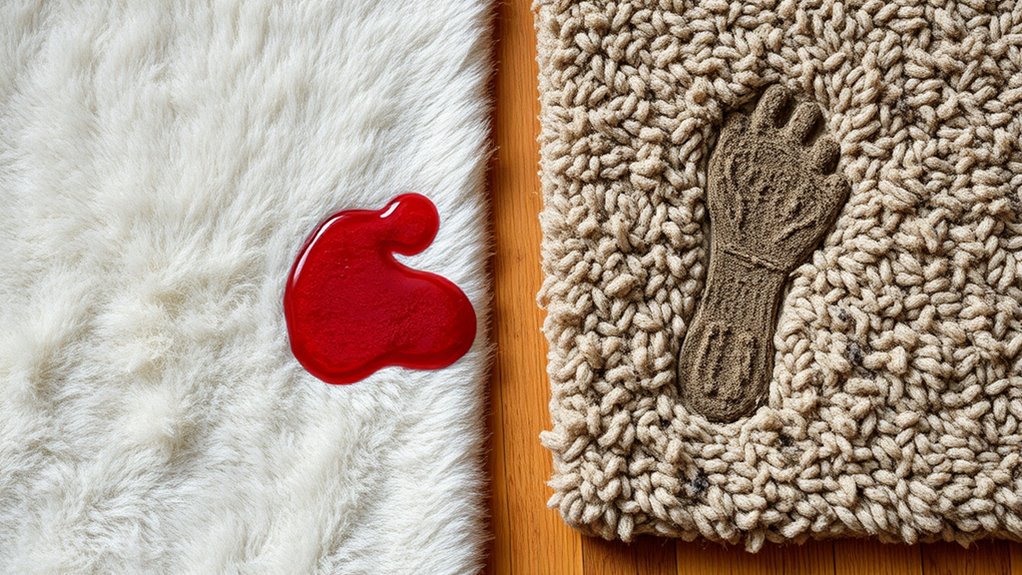
When it comes to cleaning and stain resistance, silk rugs often require more delicate handling than wool rugs. Silk’s fine fibers make it more susceptible to staining and damage, so cleaning ease is lower. Spills should be addressed immediately to prevent lasting stains. Wool rugs, on the other hand, generally resist stains better and are easier to clean. Glycolic acid benefits can help improve the appearance of rugs by promoting gentle exfoliation of surface particles, but should be used cautiously to avoid damage to delicate fibers.
Maintenance Routines and Upkeep
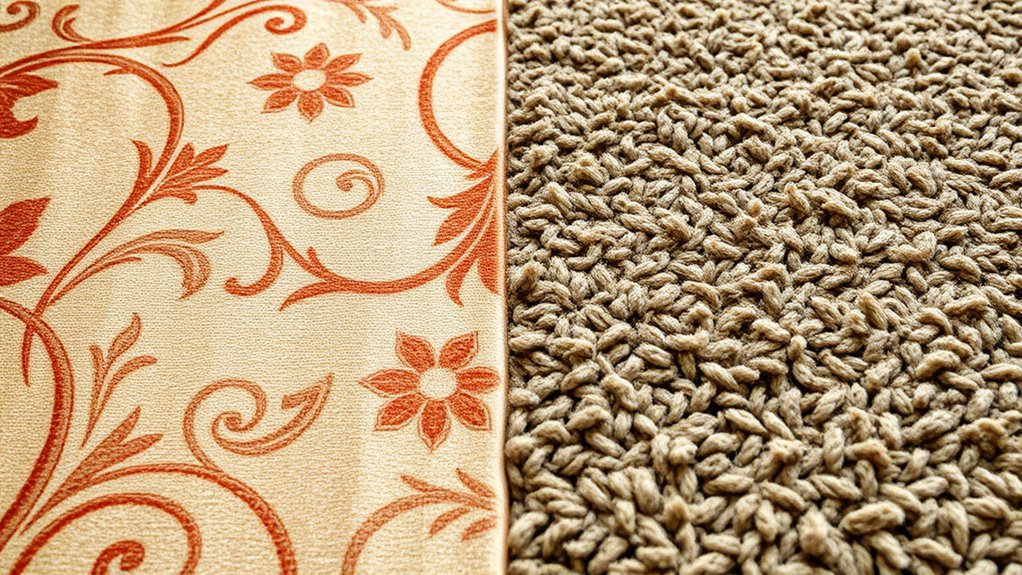
Maintaining silk rugs requires a gentle touch and regular attention to keep them looking their best, especially since their delicate fibers can be easily damaged if not cared for properly. You should vacuum silk rugs at least once a week using a soft brush attachment to prevent dirt buildup without harming fibers. Avoid aggressive vacuuming or beater bars. For spot cleaning, act quickly by blotting spills with a clean, damp cloth—never rub, as this can damage the silk. Use mild detergents specifically designed for delicate fabrics if needed. Wool rugs, by contrast, tolerate more frequent vacuuming and can handle deeper cleaning occasionally. Regular upkeep involves gentle brushing to remove loose dirt and prompt attention to stains to preserve both rugs’ appearance and longevity.
Suitability for Different Spaces
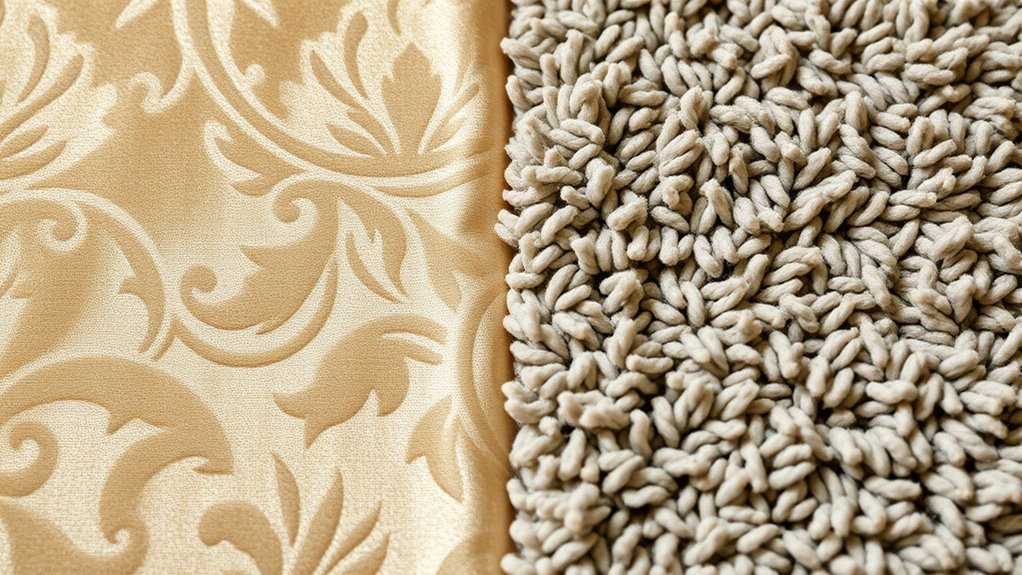
Are you wondering which rug material suits different spaces best? Both silk and wool rugs offer unique room suitability and decor compatibility. Wool rugs excel in high-traffic areas like living rooms and hallways because of their durability. Silk rugs add a touch of elegance to formal spaces, such as dining rooms or bedrooms, thanks to their sheen.
Consider these points:
- Wool’s resilience makes it ideal for busy areas.
- Silk’s delicate beauty suits more refined, less trafficked rooms.
- Wool complements rustic or casual decor styles.
- Silk enhances luxurious, sophisticated interiors.
Ultimately, your choice depends on your space’s function and style. Wool rugs provide practicality, while silk rugs emphasize elegance and decor compatibility.
Cost and Investment Value
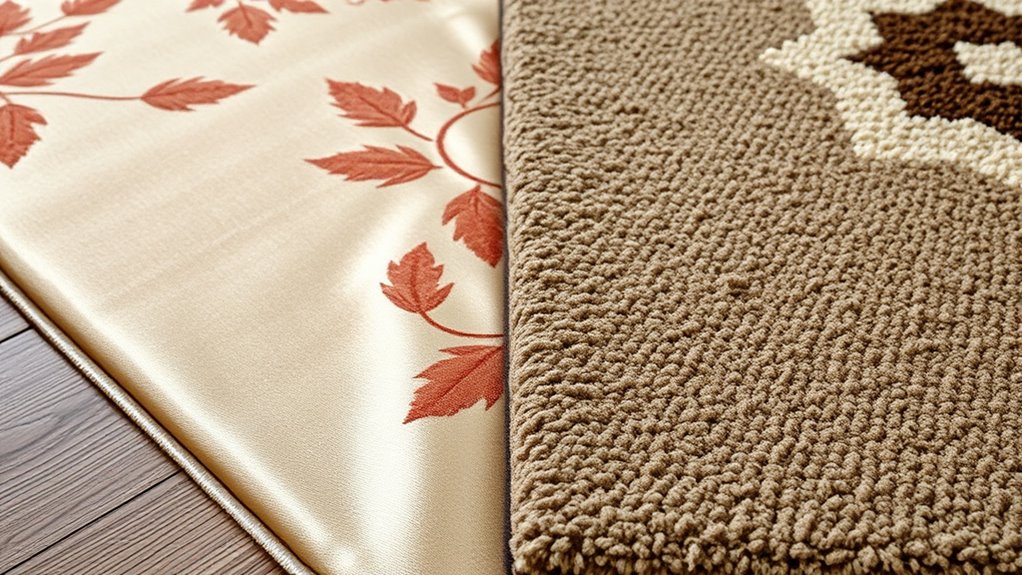
When comparing silk and wool rugs, you’ll want to contemplate the initial cost, as silk rugs tend to be more expensive upfront. Think about how long each rug will last—silk often requires more delicate care, while wool offers greater durability over time. Don’t forget to factor in maintenance expenses, which can influence the overall investment value of your choice.
Initial Purchase Price
Silk rugs typically come with a higher initial purchase price compared to wool rugs, reflecting their luxurious material and intricate craftsmanship. When considering pricing trends, you’ll find silk rugs generally cost more upfront due to their refined quality and detailed work. As a key purchase consideration, weigh the investment against the rug’s aesthetic appeal and potential longevity. While silk offers a stunning sheen, wool rugs are more budget-friendly without sacrificing durability. Keep in mind:
- Silk’s high craftsmanship increases initial costs
- Wool rugs offer a more affordable entry point
- Pricing trends may vary with design complexity
- Long-term value depends on maintenance and use
Understanding these factors helps you make smarter purchase decisions aligned with your budget and expectations for quality and appearance.
Longevity and Lifespan
While both silk and wool rugs can add beauty to your space, their longevity and lifespan vary considerably. Durability factors, such as fiber strength and weave tightness, heavily influence how long each rug will last. Wool rugs naturally resist wear and can often endure decades with proper care, maintaining their aesthetic longevity over time. Silk rugs, while stunning, tend to be more delicate; they may show signs of aging faster if exposed to heavy foot traffic or sunlight. If you’re looking for a long-term investment, wool offers greater durability and a longer lifespan, making it a wise choice for high-traffic areas. Silk rugs excel in beauty but generally require more careful handling to preserve their appearance over the years.
Maintenance Costs
Wool rugs typically demand lower maintenance costs over their lifespan, making them a more economical choice for long-term investment. They require regular vacuuming—about once a week—to remove dirt and prevent fibers from matting. When cleaning, use gentle cleaning products designed for wool to avoid damage, and always follow manufacturer instructions. Wool’s natural resilience means it’s less prone to staining and easier to maintain.
- Vacuum frequently to prolong rug life
- Use mild, wool-safe cleaning products
- Avoid harsh chemicals that can damage fibers
- Schedule professional cleaning every 12-18 months
This low-maintenance routine helps keep wool rugs looking their best without excessive spending, offering better value over time compared to silk options.
Environmental Impact and Sustainability
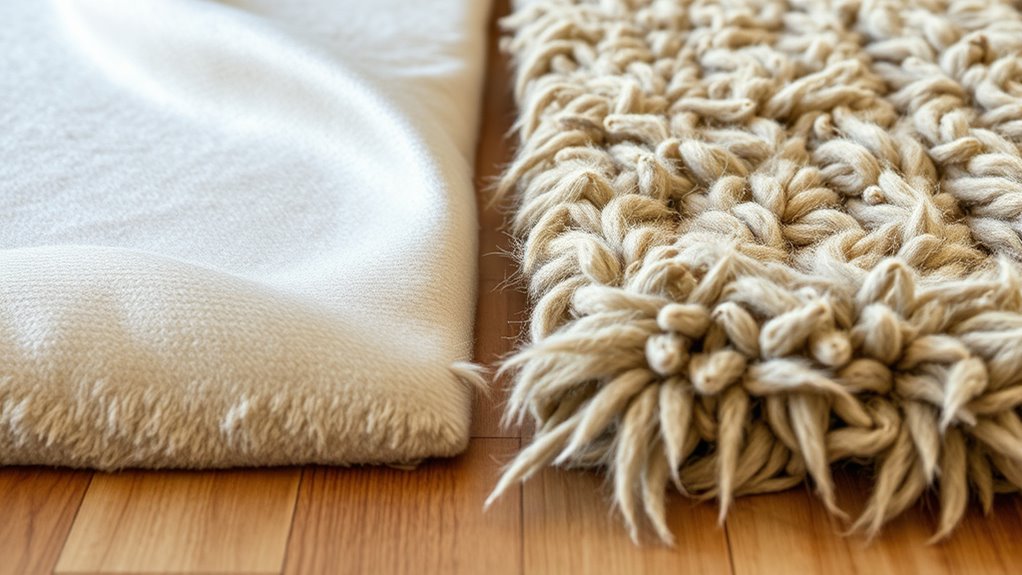
When considering the environmental impact of rugs, it’s important to recognize that silk and wool each have distinct sustainability profiles. Silk, often produced through eco friendly sourcing practices, relies on silkworm farms that can implement sustainable methods, reducing environmental harm. Its recyclability factors are favorable, as silk fibers can be regenerated or repurposed. Wool, on the other hand, is biodegradable and renewable, especially when sourced from farms that prioritize ethical and sustainable practices. Wool production generally involves less chemical processing, making it less harmful to the environment. Both materials can be environmentally responsible choices if you prioritize eco friendly sourcing and consider their lifecycle impacts. Overall, selecting rugs made from sustainably sourced silk or wool helps reduce your ecological footprint and supports eco-conscious manufacturing.
Common Use Cases and Recommendations
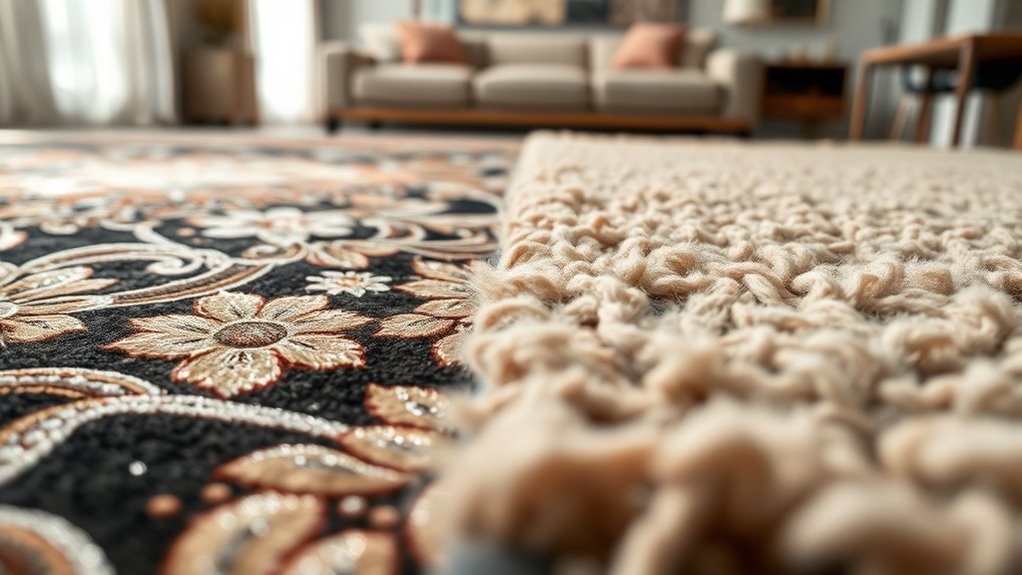
Silk and wool rugs each serve specific purposes and suit various environments, making them versatile choices for different spaces. Silk rugs excel as decorative accents due to their sheen and intricate designs, perfect for formal areas or low-traffic spots. Wool rugs are durable and comfortable, ideal for high-traffic areas like living rooms or entryways. When choosing, consider allergy considerations—wool can trap dust, while silk may be better for allergy sufferers.
Key recommendations include:
- Use silk rugs in low-traffic, decorative spaces
- Opt for wool rugs in high-traffic, cozy zones
- Consider allergy sensitivities before selecting
- Use wool for durability and silk for visual appeal
Frequently Asked Questions
Which Rug Type Is More Hypoallergenic, Silk or Wool?
If you’re allergen sensitive, wool rugs are usually better because they trap less dust and allergens, making cleaning easier. Silk rugs tend to attract more dust and can harbor allergens in their fine fibers. Wool’s natural fibers resist dust accumulation better, reducing potential reactions. So, for a more hypoallergenic option, you likely prefer wool rugs. Regular vacuuming helps keep dust and allergens at bay, improving your indoor air quality.
How Do Silk and Wool Rugs Perform in High Humidity Areas?
Like a delicate dance with nature, your choice of rug reacts to high humidity. Silk rugs, being more sensitive, can absorb moisture, increasing mold susceptibility and suffering from humidity impact. Wool rugs handle moisture better, resisting mold and maintaining their integrity longer. In high humidity areas, opt for wool to keep your space safe and beautiful, as silk’s fragility makes it less suitable for such environments.
Can Silk or Wool Rugs Be Safely Used Outdoors?
You can’t safely use silk or wool rugs outdoors, as they lack outdoor durability and aren’t pest resistant. Exposure to moisture, sunlight, and pests can damage these rugs quickly, causing fading, mold, or pest infestations. For outdoor spaces, opt for rugs specifically designed for outdoor use, which offer better resistance to weather, UV rays, and pests, ensuring your rug stays looking good and lasts longer.
What Are the Best Methods to Prevent Fading in Silk or Wool Rugs?
Fading in silk or wool rugs is like a sunset slowly dimming; you can prevent it with simple steps. Use UV protection, such as window coverings or UV-resistant sprays, to shield your rugs from sunlight. Proper storage during off-seasons keeps them safe from light exposure and environmental damage. Regularly rotate your rugs to ensure even wear and fading, helping preserve their vibrant colors and beauty over time.
Are There Any Health Risks Associated With Cleaning Silk or Wool Rugs?
You might wonder if cleaning silk or wool rugs poses health risks. Generally, gentle cleaning methods minimize concerns, but if you have allergy triggers or chemical sensitivities, you should be cautious. Harsh chemicals can irritate your skin or respiratory system, so opt for natural or eco-friendly cleaners. Always guarantee proper ventilation during cleaning to avoid inhaling fumes, and consider professional cleaning if you’re sensitive to certain substances.
Conclusion
If you’re choosing between silk and wool rugs, consider your space and lifestyle. For example, a family with young kids might opt for durable wool, while a formal living room could benefit from the sheen of silk. Think about maintenance and longevity—wool offers resilience, while silk provides elegance. Whatever you pick, investing in the right rug can transform your home, blending durability with beauty for years to come.
